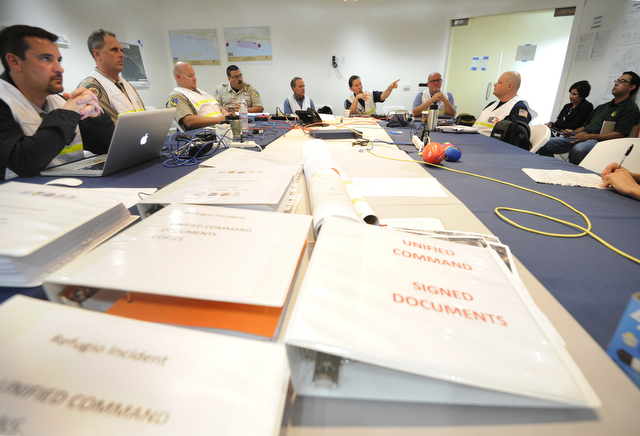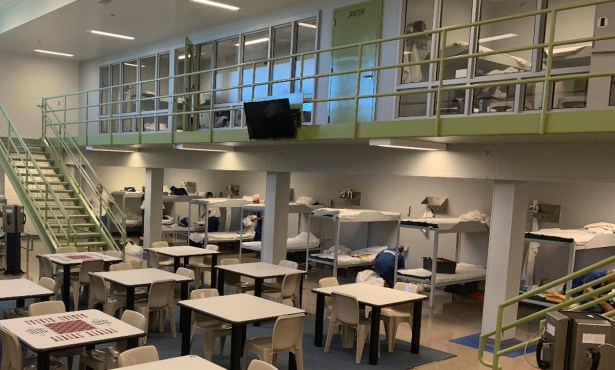News Commentary: Refugio Officials ‘Target’ Specific Reporters
Six 'Neutral to Positive' Journalists Handpicked to Spread Message of Cleanup Progress

An official report created last week identified six “neutral to positive” journalists who have covered the Refugio Oil Spill, seeking to “target” them so they publish stories about “significant progress” of the cleanup effort.
Drafted by Unified Command — a mix of government agencies and executives from Plains All American Pipeline, the company responsible for the spill — the document lists “recommended reporters” with their photos and short bios pulled from the Internet, and it grades them based on their reporting style. I was deemed “neutral,” “accurate,” “detailed,” and “mostly balanced.”
Mostly balanced? I’m not certain how I earned this gratifying distinction, but when I called the Joint Information Center (JIC) to ask about the report and how journalists were selected, U.S. Coast Guard Chief Petty Officer Kip Wadlow told me authorities chose reporters based on who requested the most information and then turned that material into news stories. “Our main goal is to ensure timely release of accurate information to the public,” he explained.
The Los Angeles Times’s Javier Panzar, Noozhawk’s Lara Cooper, KEYT’s John Palminteri, Univision’s Juan Gonzalez, and Santa Barbara Independent photographer Paul Wellman also made the list. All six of us were invited to a private press conference last Wednesday. According to Wadlow, the JIC does not grant exclusives, though they wanted to engage with reporters one-on-one to reduce any public misunderstandings about the shifting location of response teams. “Our goal is to be as transparent as possible,” he said.
Current media interest in the spill cleanup is “moderate,” the report states, with most inquiries about wildlife impacts, the investigation into the rupture, and the response timeline. The report warns that the public — without a clear understanding — might think response teams are abandoning certain areas as cleaning efforts wind down. It’s important to “get ahead of these incorrect concerns,” the report goes on, and “not leave tarballs or questions on oil fingerprinting as the main topics currently trending media coverage.”
The report also mentions there have been a couple of recent “neutral to negative” local news stories about “perceived lack of accessibility” to the Unified Command and in-field operations. For the record, every time I called the JIC, a friendly media specialist answered the phone, wrote down my questions, and got back to me with answers. The logic, I presume, is that it’s better to centralize information so second-hand tidbits don’t end up as headlines. On Monday, when I left a message with the Santa Barbara’s Office of Emergency Management (OEM), the Coast Guard’s Wadlow returned my call.
It’s worth noting Wadlow arrived in town June 12 to become the latest chief public information officer (PIO) to run the JIC. Initially, the media center was packed with 20 to 25 PIOs from multiple out-of-area agencies, but that number decreased after the Unified Command post moved from OEM headquarters — which was bursting at the seams — to the old Decker’s building near the airport. Just a few information officers remain in the JIC. Most stick to brief scripted responses when questioned by reporters.
County officials have expressed their own frustrations over communication issues. Supervisors Doreen Farr and Janet Wolf told federal officials at a May 26 board meeting that they were taken aback when Plains security guards — working under the Unified Command — tried to stop them multiple times from entering the OEM building; in one instance, Farr said, she had to point to her picture on the wall and exclaim, “That’s me!”
The media report ends with bulleted talking points that anyone at all familiar with the spill has been inundated with for nearly a month. For instance, it says, members of the response team cannot speak to the investigation; the excavation of the pipeline occurred on May 28 under the oversight of Pipeline and Hazardous Materials Safety Administration (PHMSA); dispersants were not used; the fishery closure — 23 miles long and six miles from shore — remains in effect until further notice; Refugio and El Capitan beaches are still locked down.
The report shows just how carefully Unified Command hopes to spread its message of progress. That message was clear during a tour of the Unified Command post last week. Again, everyone could not have been friendlier. I sat at a large table with representatives from all of the involved parties — from county officials to Plains executives. U.S. Coast Guard Captain Jennifer Williams, who has been in charge of operations from the get-go, defended the official cleanup response, calling it “phenomenal.”
To date, Plains is on the hook for more than $70 million in cleaning costs, averaging about $3 million per day, excluding claims. Plains spokesperson Meredith Matthews declined to disclose the number of claims the company has received to date; she added that “every claimant has been contacted” and that they meet with each party and “promptly review supporting documentation to substantiate a claim.”
In and of itself, the JIC’s media report is fairly benign, but from a reporter’s perspective, such an orchestrated invitation to such a small press conference is fairly odd, especially considering the size and scope of the spill and its aftermath. I can’t help but wonder if I’ll be invited to the next one.



